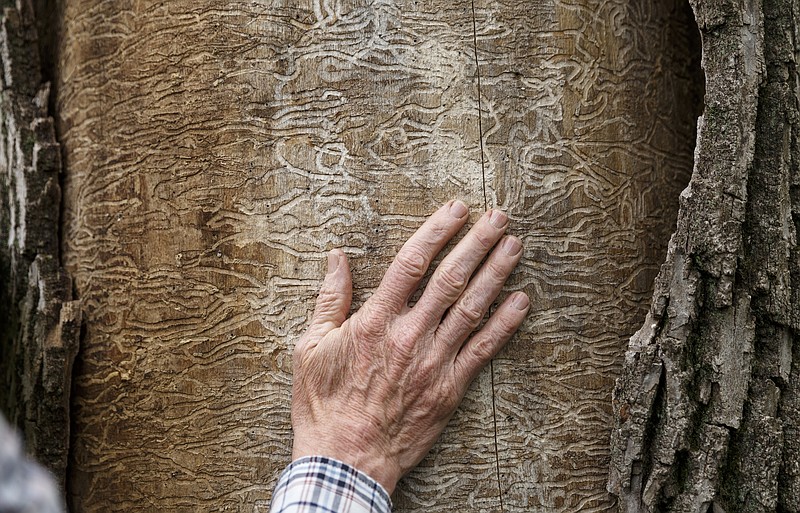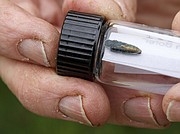Jimmy Voyles has a $5,000 problem everyone with an ash tree in their yard needs to know about - because it soon will be their problem, too.
On April Fool's Day afternoon, several blocks from Amnicola Highway in East Chattanooga, the trees in Voyles' yard were all starting to bud bright green - except for four large ash trees. Broken branches lay on the ground beneath them, and on one, the bark had peeled away to reveal a strange pattern resembling a New York subway system map, with a network of tunnels making S-curves down the side of the tree.
All four were dead, a stark example of what a nasty new pest is going to do to every ash tree in town.
Voyles said he was told it would cost $5,000 to remove the four trees, money he does not have.
"We're on a fixed income," Voyles said, "and don't have the money."
But if he does not take down the trees, he risks having them fall over on his house and cause even greater damage.
That is a dilemma every homeowner in the Chattanooga area with an ash tree in his or her yard is going to face, according to city forester Gene Hyde.
"When all is said and done, this is going to be the most destructive forest insect pest to ever come into this country," said Hyde, as he examined the trees in Voyles' yard.
The pest is the emerald ash borer, a small beetle with a jewel-green body that, as its name implies, tunnels only through ash trees.
The bug was imported by mistake from Asia, possibly from China, Hyde said, and probably in wooden pallets of ash wood infected with the larvae of the beetle. It showed up in the Detroit area in 2002, an ideal jumping-off spot from the insect's point of view because about 20 percent of the trees nearby are ash.
"It was a perfect world for these little critters," Hyde said. "There was a tremendous banquet of ash trees in front of them and no natural predator to keep them in check."
The borer was first seen in Chattanooga in 2012, Hyde said, near a railroad track about four blocks from Jimmy Voyles' neighborhood. It has spread about a mile each year since then, he said, but he is worried the borer is on the verge of really taking off.
"There is a period of six to seven years it takes before they really start to spread like wildfire," Hyde said. "So far, it has been four years. So we've got another couple of years before we really see huge amounts of the critter."
The beetle is in 47 of Tennessee's 95 counties, according to Heather Slayton, an expert on the emerald ash borer with the Tennessee Department of Agriculture.
"We have seen mortality and devastation in the east, but our [ash] population is not as thick," Slayton said. "But it is now getting into Middle Tennessee and will be more eye-opening. Public awareness will increase 10-fold over the next couple of years."
The problem for homeowners and utility companies is not just that the borer will kill every ash tree - it's the way it does it, Hyde said. The small worm that is the insect's larvae starts eating about halfway up the trunk, well above eye level, and then chews its way down the trunk in an S-shaped pattern, below the bark. The result is that instead of a few branches falling off, leaving the trunk upright, the trunk itself is severely weakened so the entire tree often topples, extending the distance its collapse can reach.
That means if a utility company wants to avoid power outages from trees falling on power lines, workers need to identify the dead ash trees and remove them within about a year after they die, Hyde said.
A spray pesticide doesn't work with the ash borer, since the larvae are inside the tree. The pesticides that are available must be injected into the ground around the tree or into the tree itself and cost about $12-$15 per inch of diameter of the tree trunk. So a typical ash about 10 inches in diameter would cost $120-to-$150, and the injection only works for a couple of years, Hyde said, and then must be repeated.
The metro area has about 200,000 ash trees, Hyde said, about 1 percent of the 20 million trees he estimates are in the region.
Chattanooga has two major ash varieties, the green ash that tends to grow in low-lying areas along creek banks, and the white ash, which can be found on hillsides.
So far, the emerald ash borer has spread from East Chattanooga to the South Chickamauga Creek area, but it has yet to extend its reach across the river into North Chattanooga.
That will only be a matter of time, the agriculture department's Slayton said, and the insect may not have to leave its home trees to get there. A major reason the insect spreads is that infested trees die and are cut up into firewood, and the firewood is carried elsewhere, carrying the larvae along with it.
"Their transportation is accelerated by artificial movement," she said. "You have someone take a tree bough and chop it into firewood and haul it away - and they just transported it."
As more and more ash trees die in coming years and there is more wood to be hauled away, that threat will grow, Slayton said.
In response, Slayton's office has been promoting the use of backyard kilns to produce heat-treated firewood, free from the ash borer and other pests. It's a low-cost business that should appeal to small farmers and loggers, she said, since it requires only a small building - or even an old railroad car - and a fuel source, which could even be firewood. The wood must be heated to a temperature of 140 degrees Fahrenheit for 60 minutes to kill all of the pests, according to federal regulations.
Then it can be sold to local businesses such as Home Depot, Wal-Mart, Whole Foods or Ace Hardware stores as heat-treated firewood.
But while that may slow down the ash borer's spread, it won't stop it.
For now, forestry officials say their best hope of containing the borer is to import its mortal enemy from Asia, a small wasp that lays its eggs on the insect's larvae and destroys them.
Officials in several Midwestern states have bred millions of the wasps and released them into the wild, and hope they will eventually reduce the emerald ash borer population to the point that some ash trees will survive.
Slayton has done the same here, personally releasing 50,000-60,000 wasps, she said.
Hyde hopes to save about 100 of Chattanooga's most majestic ash trees by regularly using pesticides. One of his prime targets is a stand of ash around the Warner Park zoo, only a few blocks from Jimmy Voyles' home in East Chattanooga.
For her part, Slayton said several government and conservation groups are collecting ash seeds and storing them, hoping that sometime in the future, perhaps 30 years from now, when the emerald ash borer threat has been contained, the trees can be replanted.
She is philosophical about how the unintended consequences of international trade can occupy so much of her time.
"Our world is changing," she said. "Increasingly, we're going to be facing these issues."
Contact reporter Steve Johnson at sjohnson@timesfreepress.com, 423-757-6673, on Twitter @stevejohnsonTFP, and on Facebook, at www.facebook.com/nooga health.

